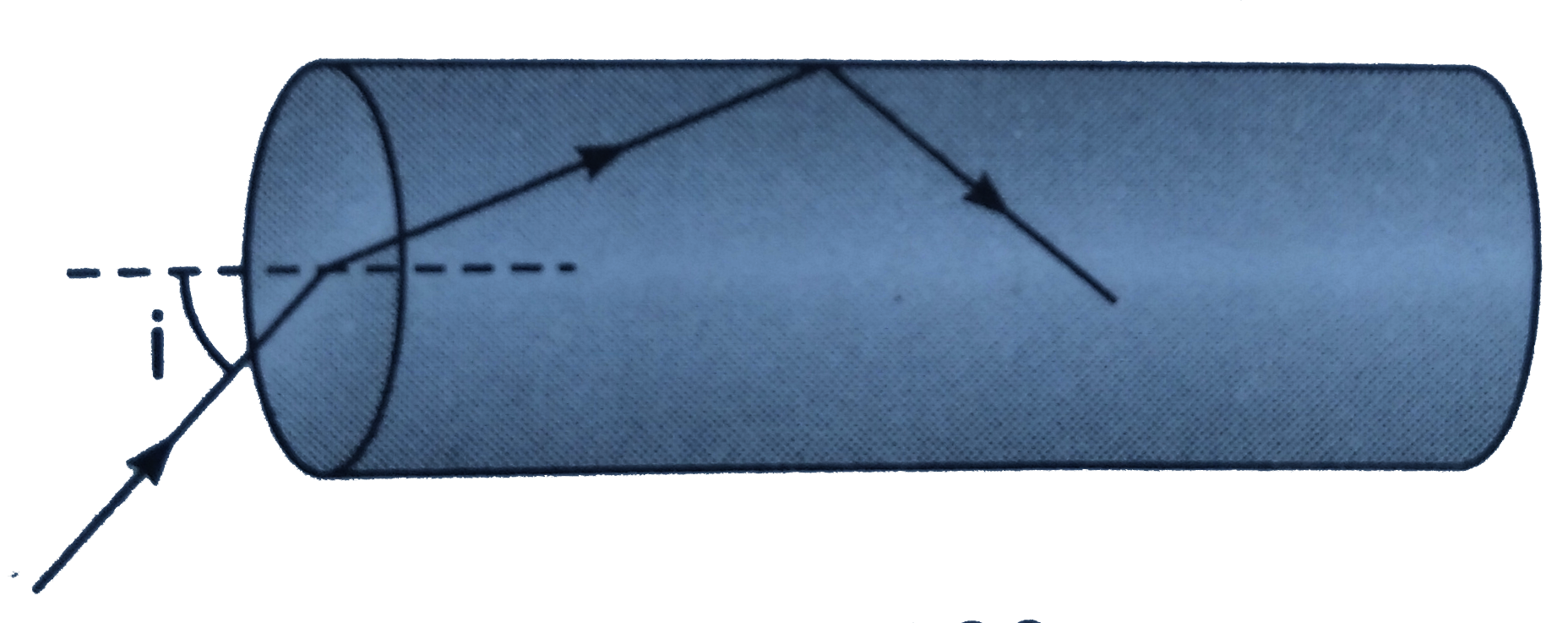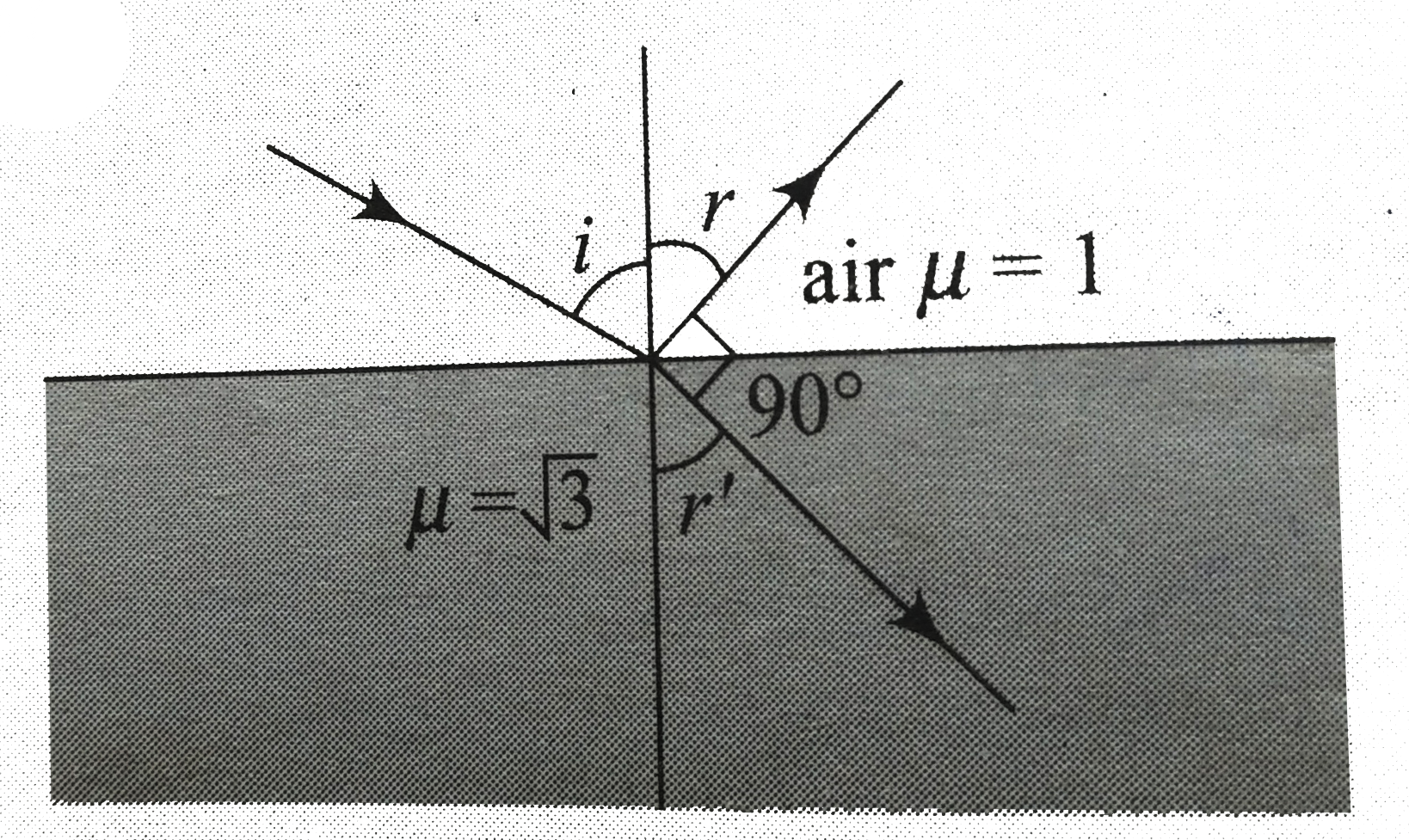Light enters at an angle of incidence in a transparent rod of refractive index n. For what value of the refractive index of the material of the rod the light once entered into it will not leave it through its lateral face whatsoever be the value of angle of incidence.
To solve the problem, we need to determine the condition under which light, once it enters a transparent rod with a refractive index n, will not exit through its lateral surface regardless of the angle of incidence. This condition is satisfied when total internal reflection occurs.
1. Understanding Total Internal Reflection (TIR):
- Total internal reflection occurs when light travels from a medium with a higher refractive index to a medium with a lower refractive index, and the angle of incidence exceeds the critical angle.
2. Identify the Relevant Angles:
- Let I be the angle of incidence when light enters the rod.
- Let R be the angle of refraction when light enters the rod.
- The lateral surface of the rod will have an angle θ with respect to the normal.
3. Using Snell's Law:
- At the first interface (air to rod), Snell's law states:
sinIsinR=n
- Rearranging gives:
sinR=sinIn
4. Relating Angles:
- For the lateral surface, the angle θ can be expressed as:
θ+R=90∘⇒θ=90∘−R
- Thus, we can express cosR as:
cosR=sin(90∘−R)=sinθ
5. Condition for Total Internal Reflection:
- For total internal reflection to occur at the lateral surface, the angle of incidence θ must be greater than the critical angle C:
θ>C
- The critical angle C is given by:
sinC=1n
6. Substituting for θ:
- We have:
θ=90∘−R
- Therefore, for TIR:
90∘−R>C
- This implies:
R<90∘−C
7. Using the Sine Rule:
- From Snell's law, we know:
sinR=sinIn
- For the maximum angle of incidence I (which is 90∘):
sinR=1n
- Therefore, substituting R into the critical angle condition gives:
sin(90∘−C)=cosC
- Thus, we have:
cosC=1n
8. Final Condition:
- For the light to not leave the rod, we require:
n>√2
Conclusion:
The refractive index n of the material of the rod must be greater than √2 for the light to undergo total internal reflection and not exit through the lateral surface.
- Total internal reflection occurs when light travels from a medium with a higher refractive index to a medium with a lower refractive index, and the angle of incidence exceeds the critical angle.
- Let I be the angle of incidence when light enters the rod.
- Let R be the angle of refraction when light enters the rod.
- The lateral surface of the rod will have an angle θ with respect to the normal.
- At the first interface (air to rod), Snell's law states:
sinIsinR=n
- Rearranging gives:
sinR=sinIn
- For the lateral surface, the angle θ can be expressed as:
θ+R=90∘⇒θ=90∘−R
- Thus, we can express cosR as:
cosR=sin(90∘−R)=sinθ
- For total internal reflection to occur at the lateral surface, the angle of incidence θ must be greater than the critical angle C:
θ>C
- The critical angle C is given by:
sinC=1n
- We have:
θ=90∘−R
- Therefore, for TIR:
90∘−R>C
- This implies:
R<90∘−C
- From Snell's law, we know:
sinR=sinIn
- For the maximum angle of incidence I (which is 90∘):
sinR=1n
- Therefore, substituting R into the critical angle condition gives:
sin(90∘−C)=cosC
- Thus, we have:
cosC=1n
- For the light to not leave the rod, we require:
n>√2
The refractive index n of the material of the rod must be greater than √2 for the light to undergo total internal reflection and not exit through the lateral surface.
Topper's Solved these Questions
- RAY OPTICSBook:DC PANDEY ENGLISHChapter:RAY OPTICSExercise:Checkpoint 9.1
Explore 10 Videos
- RAY OPTICSBook:DC PANDEY ENGLISHChapter:RAY OPTICSExercise:Checkpoint 9.2
Explore 10 Videos
- NUCLEIBook:DC PANDEY ENGLISHChapter:NUCLEIExercise:C MADICAL ENTRANCES GALLERY
Explore 46 Videos
- REFLECTION OF LIGHTBook:DC PANDEY ENGLISHChapter:REFLECTION OF LIGHTExercise:Subjective
Explore 9 Videos
Similar Questions
When a ray of light is incident normally on one refracting surface of an equilateral prism (Refractive index of the material of the prism =1.5
View SolutionLight is incident at an angle i on one planer end of a transparent cylinderical rod of refractive index μ. Find the least value of μ so that the light entering the rod does not emerge from the curved surface of the rod irrespective of the value of i.

View SolutionWhen a ray of light is incident normally on one refracting surface of an equilateral prism (Refractive index of the material of the prism =1.5)
View SolutionA light of wavelength fall on a plane surface at an angle of incidence 53. The refractive index of surface material, if the reflected light is completely plane polarised is
View SolutionThe refractive index of the material of a prism is 1.5 and its refracting angle is 6º. Find the deviation produced by the prism for a small angle of incidence.
View SolutionThe refractive index of the material of a prism is 1.5 and its refracting angle is 6º. Find the deviation produced by the prism for a small angle of incidence.
View SolutionA ray of light incident at an angle 90° with the face of an equilateral prism passes symmetrically. Calculate the refractive index of the material of the prism
View SolutionA ray of light is incident on a glass sphere of refractive index 3/2. What should be the angle of incidence so that the ray which enters the sphere does not come out of the sphere ?
View SolutionWhen light rays are incident on a prism at an angle of 45∘, the minimum deviation is obtained. If refractive index of the material of prism is √2, then the angle of prism will be
View SolutionA ray of light is incident on a transparent glass slab of refractive index √3. If the reflected and refracted rays are mutually perpendicular, what is the angle of incidence?

View Solution